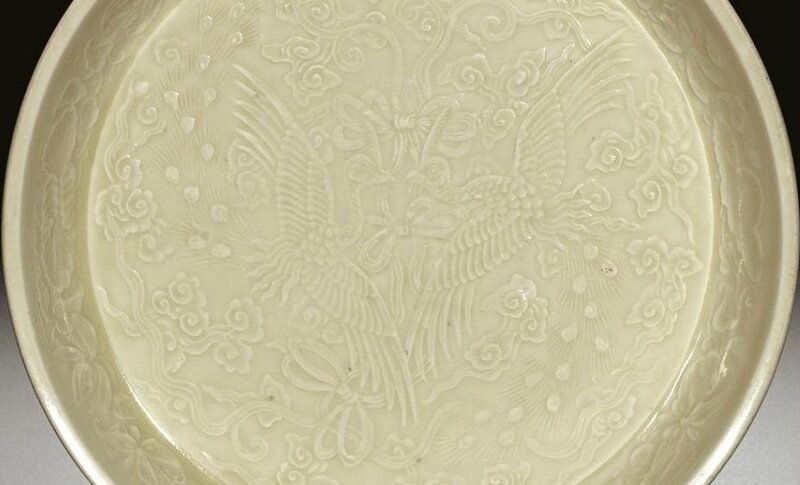Provenance: Bluett & Sons, London (paper label to the base).
Exhibited: Kunst Industri Museet, Copenhagen, 1950, n. cat. no.
Chinese Gold, Silver and Porcelain. The Kempe Collection, Asia House Gallery, New York, 1971, cat. no. 114, an exhibition touring the United States and shown also at nine other museums.
Literature: 'Hsing-Yao and Ting-Yao', The Bulletin of Far Eastern Antiquities, no. 25, 1953, Stockholm, 1953, pls. 97. 98, fig. 24.
Bo Gyllensvärd, Chinese Ceramics in the Carl Kempe Collection, Stockholm, 1964, pl. 458.
Jan Wirgin, Sung Ceramic Designs, Stockholm, 1970, fig. 21c.
Chinese Ceramics in the Carl Kempe Collection, The Museum of Art and Far Eastern Antiquities in Ulricehamn, Ulricehamn, 2002, pl. 660.
Note: The present piece belongs to a group of 'Ding' dishes that are distinguished by the extremely fine and detailed designs featuring different motifs. This dish is remarkable for its crisp design of two large superbly drawn peacocks with long sweeping tails. In their beaks they hold a long ribbon tied into a rosette and they are surrounded by swirling clouds. Further examples of dishes from this group include one decorated with two deer and pomegranate scroll, from the Victoria and Albert Museum, London, illustrated in John Ayers, Far Eastern Ceramics in the Victoria and Albert Museum, London, 1980, col. pl. 22; and a dish with a pomegranate scroll design from the Nydell collection, published in Jan Wirgin, Song Ceramic Designs, Stockholm, 1970, pl. 95b.
The peacock seems to be closely connected with the phoenix in Chinese art, not only in its physical attributes but the birds are also found together and sometimes the peacock seems to be a substitute for the phoenix. Symbolic of beauty and dignity, the Book of Changes (Yijing) calls the peacock a cultured bird that brings civilisation to the world. When depicted in pairs they are likely to symbolise happy marriage. It is rare to find 'Ding' wares decorated with peacocks, although a dish with a central peacock amidst flowers and foliage, from the Avery Brundage collection, is illustrated in Rene-Yvon Lefebvre d'Argence, Chinese Ceramics in the Avery Brundage Collection, Berkeley, 1967, pl. XXXIVc; another with a design of peacocks among peonies from the Percival David Foundation, London, is included in Oriental Ceramics: The World's Great Collections, vol. 6, Tokyo, 1982, col. pl. 16; another with a peacock by a rock illustrated in Chugoku toji zenshu, vol. 9, Kyoto, 1981, pl. 107; and a fourth dish of shallow rounded form, moulded with two peacocks among flowers, sold in these rooms, 9th June 2004, lot 156.
Sotheby's. London, Masterpieces of Chinese Precious Metalwork: Early Chinese Gold and Silver, 14 May 2008

/https%3A%2F%2Fprofilepics.canalblog.com%2Fprofilepics%2F1%2F0%2F100183.jpg)
/https%3A%2F%2Fstorage.canalblog.com%2F03%2F02%2F119589%2F96711876_o.jpg)
/https%3A%2F%2Fstorage.canalblog.com%2F11%2F31%2F119589%2F94773502_o.jpg)
/https%3A%2F%2Fstorage.canalblog.com%2F20%2F83%2F119589%2F94772815_o.jpg)
/https%3A%2F%2Fstorage.canalblog.com%2F26%2F72%2F119589%2F75604929_o.jpg)
/https%3A%2F%2Fstorage.canalblog.com%2F59%2F60%2F119589%2F26458628_o.jpg)




/http%3A%2F%2Fstorage.canalblog.com%2F99%2F20%2F119589%2F128975976_o.jpg)
/http%3A%2F%2Fstorage.canalblog.com%2F67%2F27%2F119589%2F128312691_o.jpg)
/http%3A%2F%2Fstorage.canalblog.com%2F57%2F26%2F119589%2F128308274_o.jpg)
/http%3A%2F%2Fstorage.canalblog.com%2F69%2F24%2F119589%2F128072535_o.jpg)